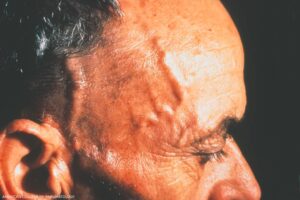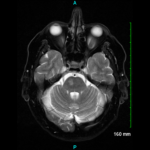
In this image, the dilated branches of the temporal artery of a patient with giant cell arteritis are seen. (Click to enlarge.)
Many patients with giant cell arteritis (GCA) who received upadacitinib (Rinvoq) plus a glucocorticoid taper regimen achieved sustained remission, according to a recently published study.1
Upadacitinib could be a long-term therapy that is safer than prednisone, commonly prescribed for GCA, results of the international SELECT-GCA study suggest. It found that 46.4% of patients on 15 mg of upadacitinib daily achieved remission without any rescue glucocorticoids during weeks 12–52 in the 52-week study, compared with 29.0% of 112 patients assigned to a placebo group with an extended glucocorticoid tapering schedule.
GCA, a vascular inflammatory disease, affects primarily large and medium-sized arteries, especially branches of the aorta that supply blood to the head, neck and upper limbs. Symptoms include headaches, scalp, temple or jaw pain, vision impairment and problems related to lack of blood flow. GCA mostly affects adults aged 50 and older, with a global prevalence of 51 cases per 100,000 in this group. The disease is more common in women and in northern European countries and U.S. regions with large populations with northern European ancestry.
Upadacitinib, an oral biologic drug, is currently used to treat various inflammatory diseases, including rheumatoid arthritis, psoriatic arthritis, Crohn’s disease and juvenile arthritis. The drug reduces inflammation by blocking Janus kinases (JAKs), enzymes involved in the inflammatory response. In April, the European Commission (EC) and the U.S. Food & Drug Administration both approved upadacitinib to treat GCA.
The most common drug used to treat GCA is prednisone, a glucocorticoid associated with many adverse events, especially among older patients with coexisting medical conditions.
Treatment for GCA is usually 12–18 months of glucocorticoids. The present study shows that upadacitinib combined with only six months of prednisone is superior to 12 months of prednisone alone, said first author Daniel Blockmans, MD, PhD, a general internist and professor of medicine at Belgium’s Leuven University. “If a patient does not do well on steroids, if he relapses often or if the patient [can’t tolerate] steroids because of the side effects, now there is another oral drug,” he notes.
In contrast, the only other drug approved for the treatment of patients with GCA, tocilizumab (Actemra), must be injected. Most elderly people prefer pills to injections, Dr. Blockmans says. Tocilizumab reduces inflammation by blocking the interleukin 6 (IL-6) receptor.

